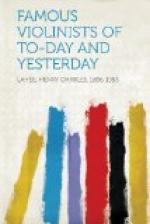CHAPTER I.
Introductory.
There is no instrument of music made by the hands of man that holds such a powerful sway over the emotions of every living thing capable of hearing, as the violin. The singular powers of this beautiful instrument have been eloquently eulogised by Oliver Wendell Holmes, in the following words:
“Violins, too. The sweet old Amati! the divine Stradivari! played on by ancient maestros until the bow hand lost its power, and the flying fingers stiffened. Bequeathed to the passionate young enthusiast, who made it whisper his hidden love, and cry his inarticulate longings, and scream his untold agonies, and wail his monotonous despair. Passed from his dying hand to the cold virtuoso, who let it slumber in its case for a generation, till, when his hoard was broken up, it came forth once more, and rode the stormy symphonies of royal orchestras, beneath the rushing bow of their lord and leader. Into lonely prisons with improvident artists; into convents from which arose, day and night, the holy hymns with which its tones were blended; and back again to orgies, in which it learned to howl and laugh as if a legion of devils were shut up in it; then, again, to the gentle dilettante, who calmed it down with easy melodies until it answered him softly as in the days of the old maestros; and so given into our hands, its pores all full of music, stained like the meerschaum through and through with the concentrated hue and sweetness of all the harmonies which have kindled and faded on its strings.”
Such, indeed, has been the history of many a noble instrument fashioned years and years ago, in the days when violin playing did not hold the same respect and admiration that it commands at the present time.
The evolution of the violin is a matter which can be traced back to the dark ages, but the fifteenth century may be considered as the period when the art of making instruments of the viol class took root in Italy. It cannot be said, however, that the violin, with the modelled back which gives its distinctive tone, made its appearance until the middle of the sixteenth century. In France, England, and Germany, there was very little violin making until the beginning of the following century. Andrea Amati was born in 1520, and he was the founder of the great Cremona school of violin makers, of which Nicolo Amati, the grandson of Andrea, was the most eminent. The art of violin making reached its zenith in Italy at the time of Antonio Stradivari, who lived at Cremona. He was born in 1644, and lived until 1737, continuing his labours almost to the day of his death, for an instrument is in existence made by him in the year in which he died. It is an interesting fact that the art of violin making in Italy developed at the time when the painters of Italy displayed their greatest genius, and when the fine arts were encouraged by the most distinguished patronage.




